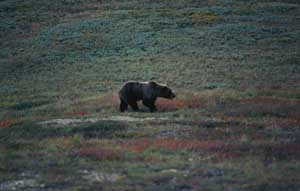|
|
 49 bears DHJanzen101181.jpg high resolution
|
|
| The Arctic would not be complete without at least a mention of bears. The polar bear (not shown) is the largest terrestrial predator remaining in the New World (though Kodiac bears run a close second), and to be fair, it mostly takes marine mammals for food (it needs the winter ice to get to where the seals are perched on it, making the summer the hard time of the year). Moving just a bit south, we hit the grizzly bear (Ursus arctos, Ursidae), as this one in Mt. McKinley National Park, Alaska. Just like the black bear we have already looked at, but twice or more as heavy, grizzly bears in subarctic habitats are highly omnivorous - ants, lemmings, fish, marine carrion, caribou, berries. However, they were also very heavily dependent on salmon runs (remember those semelparous fish) to put on the massive amounts of fat that they used to go through the winter lean months. | ||
back to lecture slides
or skip to: